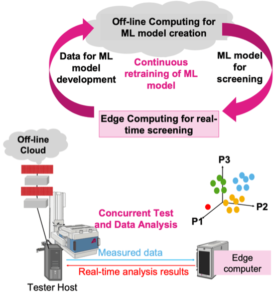The Synopsys/Ansys announcement brought financial people rushing towards EDA, but they are missing the point.

In a recent story, I talked about how EDA has gained respect in the financial markets, which is something it has failed to do for decades. EDA, in the eyes of Wall Street, had become a plodder through good times and bad, failing to achieve the growth shown by semiconductor companies or foundries, or the rapid rise to glory of other software companies. Of course, it never experienced the same depth of crashes over the years, but nobody takes notice of someone who does less bad.
At the same time, EDA companies offered no dividends because of the reinvestment rate needed to maintain their technology. And while they had built a very strong defensive moat around the industry, investors couldn’t see where future growth was going to come from, especially during the period when design starts were in decline.
After the ’90s, mergers and acquisitions in the industry started to decline. The industry had already gone through significant consolidation, and while some did happen, it was not enough — not big enough to interest the large financial houses. Those are often the people who push further consolidation, just so they can get a cut of the action.
That all started to change a couple of years ago, thanks to things like the trade war with China and the CHIPS Act. People outside the industry started to understand that EDA is actually important. As Neil Hand at Siemens said in that story, “Even though we have been changing the world on a daily basis, we have not been seen. Last year we had semiconductor people at the White House, we had EDA people talking with the President. We have suddenly become visible.”
I talk to a lot of people in other areas who want to understand more about the EDA industry — what it does, how it does it, what is changing. From information collected from me and others, they may make policy decisions, or financial decisions. Sometimes they may need to perform due diligence on a deal.
These discussions can be interesting in that they often have confirmation bias. People want to hear the things that align with what they want to be true, while ignoring the rest. Others clearly want me to summarize everything I have written over the past 2 years into a 30-minute discussion. Some say they want details about XYZ, when in reality they don’t understand the basic concepts.
These people are often in a situation of ‘they don’t know what they don’t know.’ They want an easy explanation where none exists, or they want to understand one thing, but they need background information, and they don’t have time to gather that. In some cases, they just do not have the necessary engineering background. They are often asked to do the impossible in very little time.
Having said that, I did have to chuckle a little over the recent announcement of the pending merger between Synopsys and Ansys. There is a rush to be the first to break something, and that can force them to make silly mistakes. In this case, Synopsys is an AI company, according to one news site, and Ansys was a graphics software maker, according to a popular financial TV station.
But the point of this blog is not to poke fun. It is to highlight the difficulty we have in communications with people outside of the industry. Even different groups within high-tech have this difficulty. How many times have you seen a hardware developer and software writer sitting down discussing product details? Until recently, foundries and EDA didn’t talk much. A new standards group proposal within Accellera has been looking at how to enable systems companies to speak with semiconductor companies.
One of the reasons for the Synopsys-Ansys merger is that the systems industry and semiconductors are coming closer together, and EDA is right in the middle of it. The Siemens-Mentor acquisition was an early example of this. Industry 4.0, automotive, medical, Mil/Aero – they are all going through a transformation, and it takes a long time to build trust, to be able to talk to each other intelligently, to be able to collaborate. In the merger statement, Synopsys acknowledged this, saying the deal significantly expands their total addressable market.
The industry is going through the most rapid phase of growth that it has seen in a long time. That growth is not within the space it has operated in before. It is expanding into adjacent industries, growing into verticals, and building bridges between what were separated silos. And that is what makes the Synopsys-Ansys deal so interesting.

- SEO Powered Content & PR Distribution. Get Amplified Today.
- PlatoData.Network Vertical Generative Ai. Empower Yourself. Access Here.
- PlatoAiStream. Web3 Intelligence. Knowledge Amplified. Access Here.
- PlatoESG. Carbon, CleanTech, Energy, Environment, Solar, Waste Management. Access Here.
- PlatoHealth. Biotech and Clinical Trials Intelligence. Access Here.
- Source: https://semiengineering.com/respect-confused/
- :has
- :is
- :not
- :where
- 27
- 60
- 80
- 9
- a
- Able
- About
- According
- Achieve
- acknowledged
- acquisition
- acquisitions
- Act
- Action
- actually
- addressable
- adjacent
- ago
- AI
- align
- All
- All Posts
- already
- alternative
- an
- and
- Announcement
- ARE
- areas
- around
- AS
- At
- automotive
- background
- Bad
- BAILeY
- basic
- basis
- BE
- because
- become
- been
- before
- between
- bias
- Big
- Blog
- Break
- bridges
- brought
- build
- build trust
- Building
- built
- but
- by
- CAN
- Can Get
- case
- cases
- change
- changing
- China
- Chips
- CHIPS Act
- clearly
- closer
- collaborate
- come
- coming
- Communications
- Companies
- company
- concepts
- confirmation
- confused
- consolidation
- Couple
- course
- Cut
- daily
- deal
- decades
- decisions
- Decline
- defensive
- depth
- Design
- details
- Developer
- DID
- different
- Difficulty
- diligence
- discussing
- discussion
- discussions
- dividends
- do
- does
- Dont
- down
- due
- during
- each
- Early
- easy
- enable
- Engineering
- enough
- especially
- Ether (ETH)
- Even
- everything
- example
- exists
- expanding
- expands
- experienced
- explanation
- Eyes
- Failed
- failing
- financial
- First
- For
- Force
- from
- fun
- further
- future
- future growth
- gained
- gather
- get
- glory
- going
- gone
- good
- graphics
- Group
- Group’s
- Growing
- Growth
- had
- hand
- happen
- Hardware
- Have
- hear
- Highlight
- House
- houses
- How
- How To
- HTTPS
- i
- important
- impossible
- in
- In other
- industries
- industry
- industry 4.0
- information
- interest
- interesting
- into
- Investors
- IT
- jpg
- just
- Know
- large
- Last
- Last Year
- less
- like
- little
- Long
- long time
- looking
- Lot
- maintain
- make
- maker
- MAKES
- many
- Market
- Markets
- May..
- me
- medical
- Merger
- mergers
- Mergers and Acquisitions
- Middle
- missing
- mistakes
- more
- most
- much
- necessary
- Need
- needed
- never
- New
- news
- no
- None
- Notice..
- of
- offered
- often
- on
- ONE
- operated
- or
- Other
- Others
- outside
- over
- past
- pending
- People
- perform
- period
- phase
- plato
- Plato Data Intelligence
- PlatoData
- Point
- Poke
- policy
- Popular
- popularity
- Posts
- president
- Product
- proposal
- Push
- rapid
- Rate
- Reality
- reasons
- recent
- recently
- respect
- REST
- right
- Rise
- ROW
- rush
- Said
- same
- say
- saying
- see
- seen
- semiconductor
- Semiconductors
- shown
- Siemens
- significant
- significantly
- silos
- site
- Sitting
- situation
- So
- Software
- some
- Someone
- something
- sometimes
- Space
- speak
- standards
- started
- starts
- Statement
- station
- Story
- street
- strong
- summarize
- Systems
- takes
- Talk
- talking
- Technology
- text
- thanks
- that
- The
- the world
- their
- Them
- There.
- they
- thing
- things
- this
- those
- though?
- Through
- thumbnail
- time
- times
- to
- together
- Total
- towards
- trade
- Transformation
- true
- Trust
- tv
- understand
- until
- verticals
- very
- visible
- Wall
- Wall Street
- want
- war
- was
- we
- were
- What
- What is
- when
- which
- while
- white
- White House
- WHO
- with
- within
- world
- writer
- written
- xyz
- year
- years
- you
- zephyrnet












